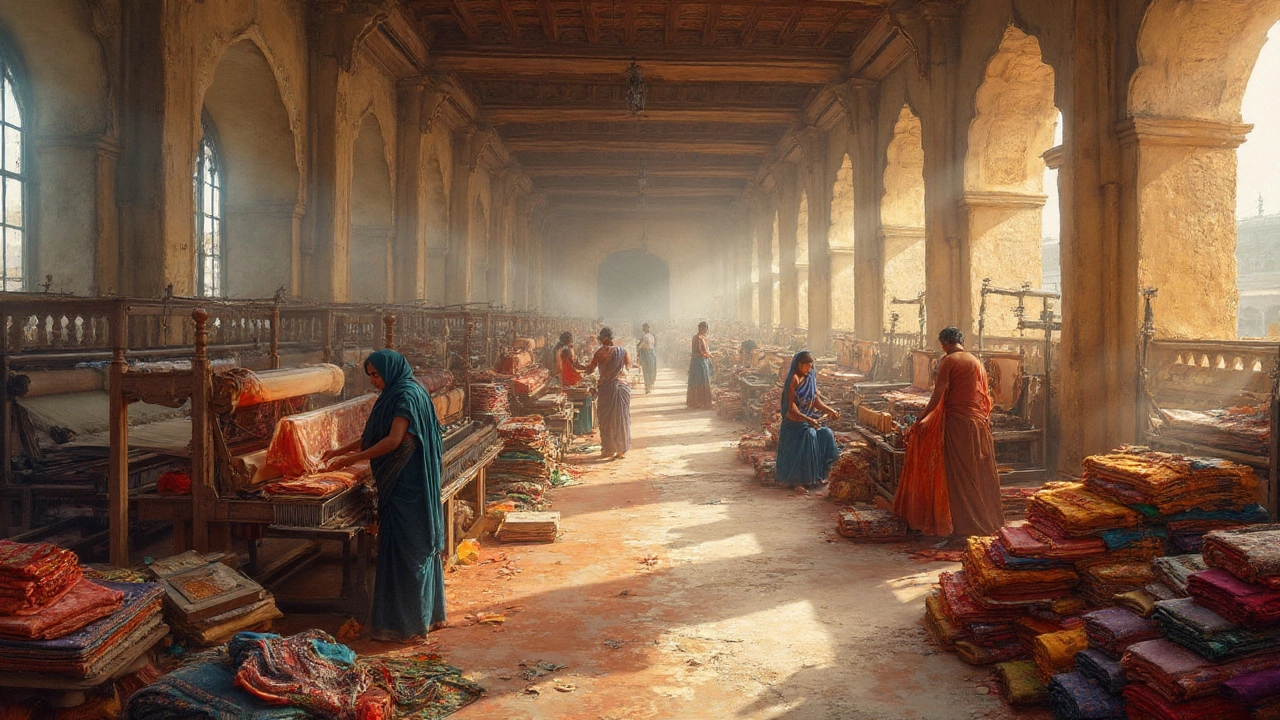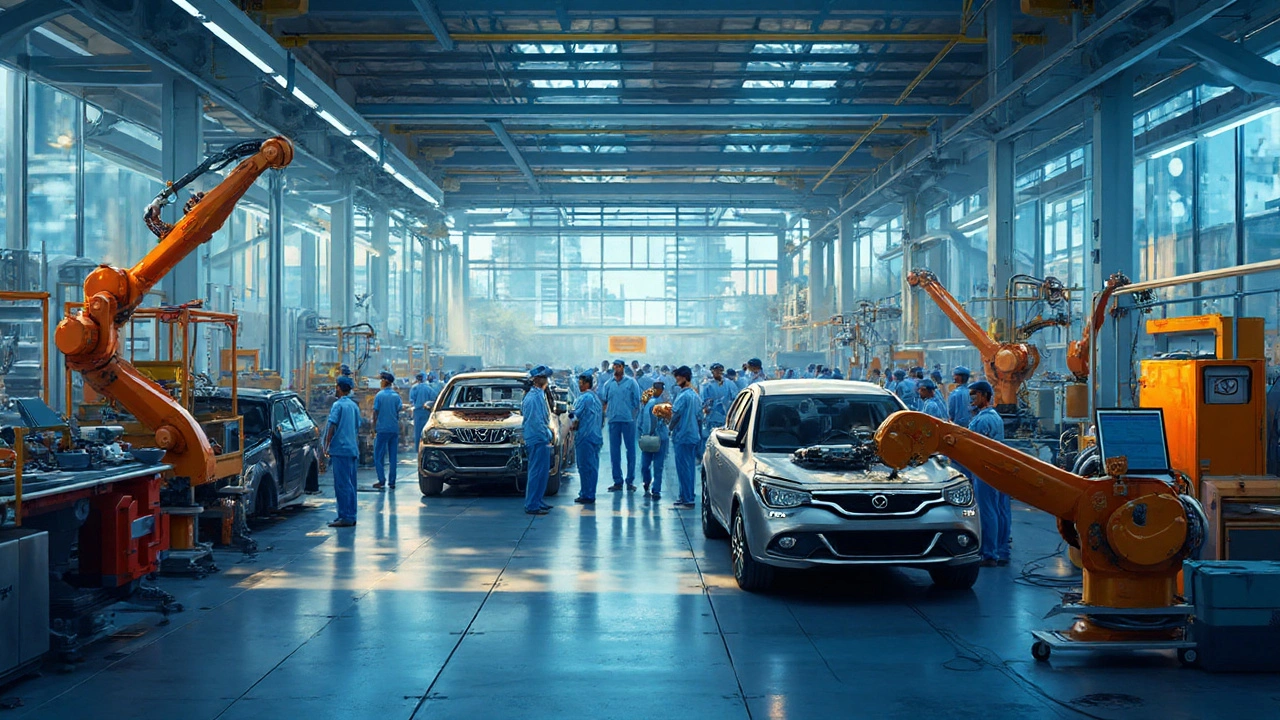Chicken tikka, cricket, and call centers might pop up first when you ask outsiders about India, but those answers miss the real engine churning behind the scenes—manufacturing. India’s factories aren’t just worker-packed assembly lines: they’re sprawling tech hubs, textile giants, and mega plants cranking out goods for the world. Imagine a country pumping out everything from the steel skeleton of buildings to the pills that fill your medicine cabinet. Now multiply that by the scale of 1.4 billion people. India’s manufacturing game is as huge as its population, but there’s still a lot folks don’t know. Everyone talks about “Make in India,” but how many understand what India’s actually making? Let’s break it down and spotlight the products and industries that really put India on the global manufacturing map.
The Rise of Indian Automobile Manufacturing
Look at Indian city traffic—those endless streams of cars, bikes, and buses. Many of those wheels were born right here in India. The car industry here isn’t just about selling to locals. Did you know India is the largest producer of two-wheelers on the planet? Brands like Hero MotoCorp and Bajaj roll out scooters and motorcycles that zip through Indian streets, but those same vehicles show up in Africa and Latin America too. It doesn’t stop at two-wheelers—India’s also a top producer of small cars. Suzuki, Hyundai, Tata—you’ll spot their compact models everywhere from Mumbai’s busy streets to London’s suburbs.
But the story gets bigger. India has become a major player in exporting auto components and even full-fledged passenger vehicles. Maruti Suzuki alone shipped out over 2.4 million cars in 2024. Local giants like Mahindra are pushing into EVs, and new policies encourage homegrown battery production. This shift is no accident. The government slashed import tariffs on car parts and rolled out schemes that put domestic manufacturing in the fast lane.
What’s surprising is how much of the high-tech stuff is now made in India. Buses, trucks, hybrid engines, electric scooters—factories here aren’t just sticking to “basic” models. The new electric buses seen in Delhi? Many are made by Tata and Ashok Leyland right at home. Auto components—brakes, clutches, and intricate electronics—come out in quantities that even supply big-league global brands like Ford and Toyota. India exports these to 160 countries. It’s the scale that blows your mind.
Here’s a snapshot that surprises most people: India is the fourth largest car manufacturer in the world now. The auto industry makes up a whopping 7.5% of India’s GDP and employs over 37 million people, directly and indirectly. To put it simply, if you ride it, drive it, or see it rolling on roads, there’s a good chance it has Indian roots.
| Product | India's Global Rank (2024) | Export Volume |
|---|---|---|
| Two-wheelers | 1st | 20 million+ |
| Passenger Vehicles | 4th | 2.4 million |
| Auto Components | 3rd | $20 billion (Value) |
If you ever wonder where the next innovation might drive in from, just watch the Indian car factories—they’re humming with action.
The Powerhouse of Textile and Apparel Production
No country wears color quite like India, but the global impact of Indian textiles is much more than fashion statements. Flip over the label of a tee at any big chain store in Europe or the US—odds are pretty good it says “Made in India.” Textile production runs in India’s veins—literally. The industry dates back thousands of years, supplying fine silks and cottons to kings and traders worldwide. Today, the textile sector is massive: India is the world’s second-largest textile and apparel producer, just behind China.
Here’s the wild part—this isn’t just about cheap shirts. Indian factories churn out everything from high-quality denim and activewear to high-end hand-knotted rugs and specialty fabrics nobody else does as well. Gujarat and Maharashtra are famous for spinning cotton, while Tamil Nadu runs on giant garment factories. Northern states like Uttar Pradesh and West Bengal have looms clacking away at exquisite sarees, intricate embroidery, and hand-woven masterpieces.
The numbers? Mind-blowing. Over 45 million people work in this sector—most of them women. Textile exports hit $33 billion last year, supplying fabric and clothes to powerhouse brands worldwide. The textile supply chain is huge—from farmers growing cotton, to dyeing plants, spinning mills, and tailoring workshops that finish the job. All together, these pieces fuel an industry that’s absolutely central to India’s economy.
One side story—India is big on eco-friendly fabrics and organic sourcing. Younger brands and upstart factories are into recycled yarn, zero-waste processes, and sustainable dyes. The “Khadi” movement, promoting hand-spun and natural fabrics, has gone mainstream again. Customers around the world want more responsible products, and Indian manufacturers are answering the call in style.
Step into a big-box retail store anywhere in the world, and you’ll find Indian raw cotton, organic linen, towels, bed sheets, or sarees stacked up. If you want to see the sheer variety of what India’s mills can do, walk any festive market in India—colors, textures, sparkling threads, and ancient patterns everywhere. And Aisha, my wife, won’t wear anything else but Indian cotton during the summer!
For those tracing the journey of everyday fashion, start with a seed in an Indian field and follow it through to the catwalk in Milan. The Indian textile story stretches across the world, one thread at a time.

Pharmaceuticals: India’s “Pharmacy to the World”
Pill bottles, syringes, and bandage packs on pharmacy shelves in Nairobi, Jakarta, or London? A good chunk likely started out in a huge plant in Hyderabad or Mumbai. The world calls India the “Pharmacy to the World,” and it’s no exaggeration. Indian pharma companies supply one out of every five generic drugs sold globally. That’s a staggering share when you think how many countries rely on affordable medicine.
The pharma sector picked up speed when Indian patent laws allowed companies to reverse-engineer expensive drugs and turn them into quality generics. Now, major players like Sun Pharma, Cipla, and Dr. Reddy’s export to over 200 countries. Indian antibiotics, blood pressure pills, and even cancer medications ship by the container-load, making a real difference in poorer nations where costlier Western brands would put care out of reach.
But it’s not just generics. India is climbing up the value chain, making vaccine doses (remember the race to roll out COVID-19 shots?), insulin, high-grade antibiotics, and even custom ingredients for global medicine brands. In fact, over 60% of the global vaccine market volume comes from Indian plants. The numbers? Exports topped $27 billion last year. India’s home to the world’s largest vaccine manufacturer, Serum Institute of India. During pandemic times, this mattered more than ever—the world literally depended on Indian factories to bridge supply gaps.
One surprising bit: India is one of the biggest suppliers for the US FDA-approved drug manufacturing plants outside the USA—over 530 such facilities. The standards here are world-class, and India is pushing hard into research for new drugs, biosimilars, and cutting-edge therapies. Got a prescription filled lately? There’s a solid chance your medicine’s made in India, no matter where you live.
| Product | Exports in 2024 (Value) | India's Global Rank |
|---|---|---|
| Generic Drugs | $21 billion | 1st |
| Vaccines | $6 billion | 1st (by volume) |
| APIs (Ingredients) | $4 billion | 2nd |
There’s a reason why so many nations keep a close eye on Indian pharma. The world needs it—and trusts it.
Steel, Chemicals, and Heavy Industries: Building Blocks of Growth
Steel doesn’t get flashy Instagram posts, but it’s in everything—cars, buildings, bridges, even those spoons in your kitchen drawer. And here’s a shocker: India is now the second-largest steel maker on earth, right after China. Tata Steel, JSW, and SAIL are names that mean business, and their factories supply steel for skyscrapers on every continent. Whether it’s rebar for Dubai towers or thick plate for African railroads, a lot of that metal started as Indian ore.
Roll up steel, and you bump into chemicals: another giant backbone. Think paint, pesticides, plastics, and rare specialty chemicals. India’s chemical sector is the sixth-largest in the world and growing at nearly 10% a year. Exports range from dyes for fashion brands to pharma-grade chemicals that end up in life-saving medicines. Chemical parks in Gujarat look like small cities—towering reactors, tanks, and pipes running for kilometers—and they’re a magnet for foreign buyers.
In heavy manufacturing, India punches above its weight. Look at power plants, railway coaches, cranes, turbines—built, assembled, and shipped around the globe. Railway coach factories near Chennai or Kapurthala supply carriages to Africa and South America. Larsen & Toubro builds power equipment exported throughout Asia. Even pre-fab bridges and large machines for agriculture—India’s got factories hustling in niches you’d never imagine.
Don’t skip plastics—India’s factories make buckets, pipes, auto parts, homeware—the works. The local plastics market is huge, but demand for cheap, decent plastic products abroad means India is a top exporter as well.
It’s hard to imagine our world without these materials, and the truth is, a surprising amount has Indian roots. If you walk on a tiled floor, sip from a plastic cup, or see a shiny aluminum frame—there’s a decent shot it’s tied to an Indian plant somewhere.

Emerging Electronics, Startups, and the Make in India Push
If you’re holding a phone, odds are some tiny part came from India. The country is gunning to become the next big electronics manufacturing hub—think smartphones, laptops, TVs, and all the guts inside them. In just a decade, electronics factories in Noida, Chennai, and Bengaluru went from assembling basics to building state-of-the-art chips, displays, and circuit boards for giants like Samsung, Apple, and Xiaomi.
The numbers tell a story: in 2024, India assembled over 240 million mobile phones, making it the world’s second-biggest producer, just behind China. Tablet production doubled in just two years, and new chip plants are breaking ground to supply the growing demand for semiconductors—India’s calling this the “chip revolution.”
But electronics aren’t the only new wave. Startups are riding the “Make in India” initiative to build smartwatches, drones, solar panels, and IoT gadgets, aiming at both local consumers and exports. State incentives, massive tech parks, and cheap skilled labor have drawn in investments from global tech firms and homegrown brands alike.
One key tip: if you’re thinking of importing electronics for your small business, keep an eye on Indian suppliers, especially as the government keeps slashing red tape and offering export incentives. And it’s not a startup-only club—traditional giants like Bharat Electronics are breaking into high-end defense and medical hardware too.
While traditional sectors keep humming, the real excitement is in the new “sunrise” sectors. Green tech, renewables, robotics, advanced batteries, and medical devices—these are the hot favorites. If you want your finger on the pulse of where manufacturing is going, not just where it’s been, India’s emerging electronics scene gives you the front row seat.
If I had to bet, I’d say the next device you buy might have a battery, screen, or sensor stamped out in an Indian city you’ve never heard of. Watch this space—India isn’t just catching up; it’s aiming to lead.

